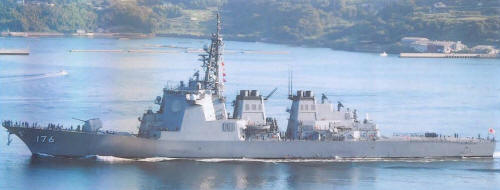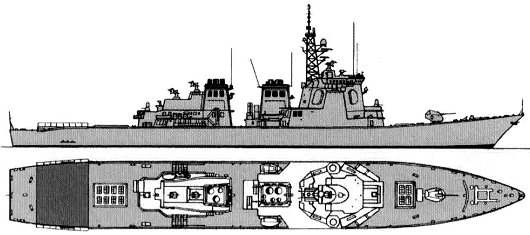
NAVYPEDIA
 Support the project with paypal
Support the project with paypal
Photo

Chokai 2008 Many thanks to ChangZhi Wang for additional information on this page.
Ships
| Name | No | Yard No | Builder | Laid down | Launched | Comp | Fate |
|---|---|---|---|---|---|---|---|
| こんごう [Kongo] | DDG173 | Mitsubishi, Nagasaki | 8.5.1990 | 26.8.1991 | 25.3.1993 | in service (2019) | |
| きりしま [Kirishima] | DDG174 | Mitsubishi, Nagasaki | 7.4.1992 | 19.8.1993 | 16.3.1995 | in service (2019) | |
| みょうこう [Myoko] | DDG175 | Mitsubishi, Nagasaki | 8.4.1993 | 5.10.1994 | 14.3.1996 | in service (2019) | |
| ちょうかい [Chokai] | DDG176 | IHI, Tokyo | 29.5.1995 | 27.8.1996 | 20.3.1998 | in service (2019) |
Technical data
| Displacement standard, t | 7250 |
|---|---|
| Displacement full, t | 9500 |
| Length, m | 150.5 pp 161.0 oa |
| Breadth, m | 21.0 |
| Draught, m | 6.20 hull |
| No of shafts | 2 |
| Machinery | COGAG: 4 General Electric LM-2500 gas turbines |
| Power, h. p. | 100000 |
| Max speed, kts | 30 |
| Fuel, t | gas turbine oil 1000 |
| Endurance, nm(kts) | 4500(20) |
| Armament | 2 x 4 Harpoon SSM (8 RGM-84), (1 x 61 + 1 x 29) Standard SM-2MR Block III SAM / ASROC VLA ASuR Mk 41 VLS (74 RIM-66, 16 RUM-139), 1 x 1 - 127/54 OTO-Melara Compact, 2 x 6 - 20/76 Mk 15 Phalanx, 2 x 1 - 12.7/90, 2 x 3 - 324 HOS-302 TT, helicopter deck |
| Electronic equipment | SPY-1D, OPS-28D, 3x SPG-62, FCS-2-23, OPS-20, 2x Mk 90 radars, OQS-102, OQR-2 sonars, NOLQ-2, OLT-3, OPN-7B ECM suites, 4x Mk 36 SRBOC decoy RL, SLQ-25 Nixie torpedo decoy, OYQ-6 CCS |
| Complement | 310 |
Standard scale images

Kongo 2000
Graphics
Project history
The design is an enlarged version of the U.S. Arleigh Burke flight I-class adding a backup surface/air-search radar, using a faster-firing 127mm gun with a dedicated fire-control system, and incorporating a more elaborate EW system with active jamming. Aegis Baseline 5 or Baseline J2 based. First ship was ordered in 1988. The great expense caused considerable resistance to the program, delaying its start by two years. The ships are intended to assist in the aerial defense of Japan as well as acting as AAW escorts for task forces.
Are equipped with the U.S. Prairie/Masker bubbler noise-radiation suppression system and have infrared exhaust signature provisions. Do not have fin stabilizers, relying on broad, fixed bilge keels and hullform for roll reduction. The deck abaft the after VLS missile installation is intended for use as a helicopter platform, but there is no hangar or deck-handling gear; twin stabilized horizon indicators are carried on the after superstructure to aid landings.
The VLS cells hold 61 missiles aft, 29 forward. The SPG-62 radar illuminators support three Mk 99 Mod. 1 missile fire-control direction systems, and the underwater battery fire-control system is the U.S. Mk 116 Mod. 7. The OQS-102 sonar is equivalent to the U.S. SQS-53C. The 12.7-mm mg and night-vision equipment were added to detect and deter infiltration craft.
Modernizations
2007, Kongo; 2008, Chokai; 2009, Myoko; 2010, Kirishima: + ability to carry Standard SM-3 Block IA (RIM-161) SAM
Naval service
No significant events.
Many thanks to ChangZhi Wang for additional information on this page.
 HOME
HOME FIGHTING SHIPS OF THE WORLD
FIGHTING SHIPS OF THE WORLD JAPAN
JAPAN TORPEDO SHIPS
TORPEDO SHIPS KONGO missile destroyers (1993 - 1998)
KONGO missile destroyers (1993 - 1998)
